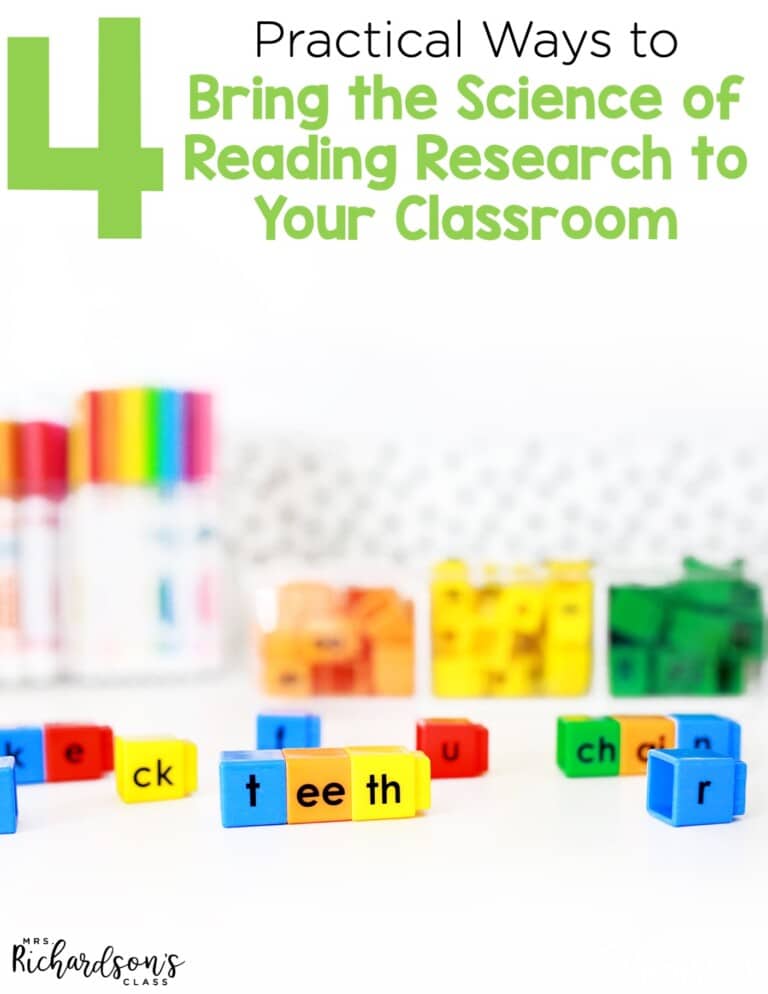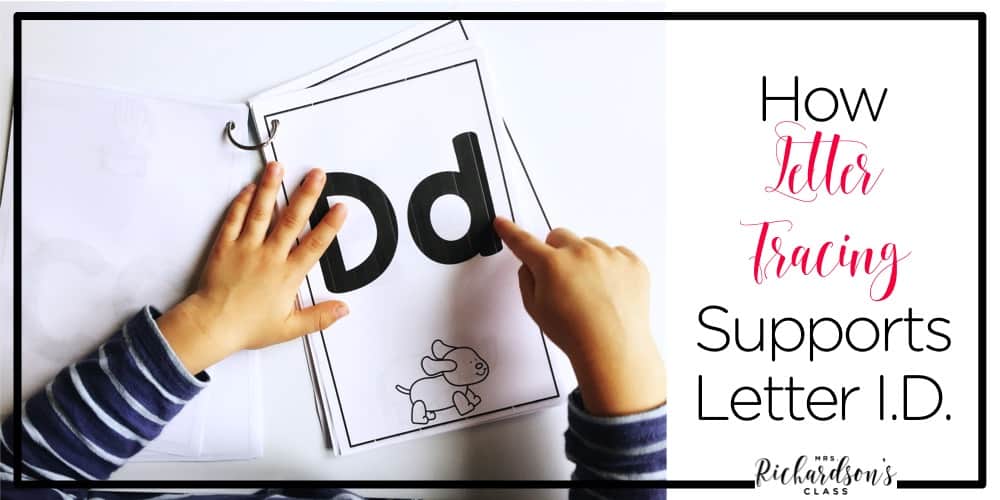


We primary grade teachers know that kids come to school with a variety of letter knowledge. Some kinder, and even first grade, students are still working on letter identification. This was the case for most of the schools I taught in.
In her book, The Next Step in Guided Reading, Jan Richardson says that students who identify less than 40 letters should be practicing letter identification daily. She suggests a letter tracing intervention to help students learn their letters quickly. It seems TOO easy, right? Jan says, “The sooner these children learn the names of the letters, the sooner they will benefit from whole-group and small-group instruction.” I cannot agree more! Research-backed, it’s a fast and simple way to improve your students’ letter identification skills.

That’s it! Simply print the letter tracing cards, hole punch them in the corner, and keep them together with an “o” ring. The alphabet book should have one letter (with both the uppercase and lowercase) and a corresponding picture on each page. Jan suggests having a parent volunteer, a teacher’s assistant, or a trained upper-grade student complete this activity with each student who needs it.

Sitting next to the student, have them trace each upper and lowercase letter with their finger and identify the picture while saying the names (i.e. “A, a, apple. B, b, ball.”). It’s important for the student to use their pointer finger (not a pencil or marker) and trace from top to bottom because “the tactile experience is essential for building a memory trace,” says Richardson.
If the student needs help tracing, only help with the letters that are necessary with the hand-over-hand method. If a student knows less than 10 letters, just have them trace the letters in their name. If they can identify 10-40 letters, they will trace the whole book daily.
If you don’t already have a letter tracing book, you can grab one for FREE below!
Do you have some students struggling with their knowledge of the alphabet? I have a growing bundle of Science of Reading Literacy Centers that focus on the alphabet, rhyming, syllables, and MORE! These activities are already planned for you!
You’ll be able to keep students engaged in purposeful activities that help build a solid foundation while you are using your science of reading small group curriculum to meet readers where they are!
The Alphabet Centers included in the bundle come with 10 ready-to-go centers to build strong alphabetic knowledge.
If you want to dive into more tips and activities for developing alphabetic knowledge, check out my blog that talks about that and the science of reading Alphabetic Knowledge: What It Is and How to Support Readers.
pin it

Want to use the latest research to boost your readers during small groups? This FREE guide is packed with engaging ideas to help them grow!

I’m a K-1 teacher who is passionate about making lessons your students love and that are easy to implement for teachers. Helping teachers like you navigate their way through their literacy block brings me great joy. I am a lifelong learner who loves staying on top of current literacy learning and practices. Here, you’ll find the tools you need to move your K-2 students forward!


| Cookie | Duration | Description |
|---|---|---|
| cookielawinfo-checkbox-analytics | 11 months | This cookie is set by GDPR Cookie Consent plugin. The cookie is used to store the user consent for the cookies in the category "Analytics". |
| cookielawinfo-checkbox-functional | 11 months | The cookie is set by GDPR cookie consent to record the user consent for the cookies in the category "Functional". |
| cookielawinfo-checkbox-necessary | 11 months | This cookie is set by GDPR Cookie Consent plugin. The cookies is used to store the user consent for the cookies in the category "Necessary". |
| cookielawinfo-checkbox-others | 11 months | This cookie is set by GDPR Cookie Consent plugin. The cookie is used to store the user consent for the cookies in the category "Other. |
| cookielawinfo-checkbox-performance | 11 months | This cookie is set by GDPR Cookie Consent plugin. The cookie is used to store the user consent for the cookies in the category "Performance". |
| viewed_cookie_policy | 11 months | The cookie is set by the GDPR Cookie Consent plugin and is used to store whether or not user has consented to the use of cookies. It does not store any personal data. |
15 Responses
Would like abc wirk aheet
Click the link above in the blog post and you can download the booklet. There are no worksheets. 🙂
Love this booklet! 🙂 Any chance the J could get the top on it?
Hi Katie! So glad you like it! This freebie is only editable in the case of an error present. Sorry! 🙂
Do you have them in lowercase letters?
Hi Kathleen! The book has both upper and lowercase letters. 🙂
Thank you so much. The letter tracing link book does not work. Can you please send it to me?
Hi Helene! Here is the link. 🙂 https://drive.google.com/file/d/1TCYK8HAtQuGSiaQJKsAEqgPUTJ6SG8xt/view
Will you marry me? Seriously, I was about to do those myself and I though “look for something in English”. There aren’t a lot of ressources in French for tracing letters and the one I have is very complicated, for instance, to trace a D, they start up, go down in a straight line, go back up on the same line they just traced then they do the half-circle. It’s nuts! Their fine skills aren’t developed enough for my students to be able to do that without writing a nightmare of a letter AND it’s that much more complicated! Gosh!
So, basically, I love you. Thank you so much for you sharing your precious material. If you need something in French, I’m your girl 😉
ha ha ha! I’m so glad you found them and can use them for your French speaking students!! YAY!
Have you ever tried something similar with children who are having difficulty with number recognition?
Hi Lynne! I have not, but I would not be surprised by it working because I think the concept is the same. Give it a try!
The book I am seeing only has lowercase for the finger tracing. There’s no lowercase for the dotted pencil tracing letters. Do you have those available?
If it is not in the download, then I do not have it at this time. I’m sorry!!